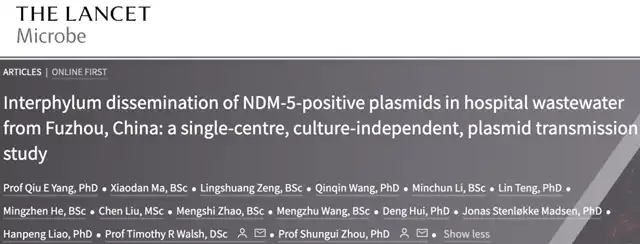Revolutionary Discovery: Carbapenem-Resistant Plasmids Break Boundaries
- Normal Liver Cells Found to Promote Cancer Metastasis to the Liver
- Nearly 80% Complete Remission: Breakthrough in ADC Anti-Tumor Treatment
- Vaccination Against Common Diseases May Prevent Dementia!
- New Alzheimer’s Disease (AD) Diagnosis and Staging Criteria
- Breakthrough in Alzheimer’s Disease: New Nasal Spray Halts Cognitive Decline by Targeting Toxic Protein
- Can the Tap Water at the Paris Olympics be Drunk Directly?
Revolutionary Discovery: Carbapenem-Resistant Plasmids Break Boundaries
- Should China be held legally responsible for the US’s $18 trillion COVID losses?
- CT Radiation Exposure Linked to Blood Cancer in Children and Adolescents
- FDA has mandated a top-level black box warning for all marketed CAR-T therapies
- Can people with high blood pressure eat peanuts?
- What is the difference between dopamine and dobutamine?
- How long can the patient live after heart stent surgery?
Revolutionary Discovery: Carbapenem-Resistant Plasmids Break Boundaries, Challenging Conventional Wisdom in Antibiotic Resistance Transmission
Carbapenem-resistant plasmids can shuttle extensively between Gram-negative and Gram-positive bacteria.
Carbapenems, a class of antibiotics known for their broad spectrum and potent activity, are hailed as the “last line of defense” against bacterial infections in humans.
However, since 2009, a global spread of bacteria resistant to carbapenems, driven by the New Delhi metallo-β-lactamase (NDM) gene (blaNDM), has been observed on a large scale.
Statistics reveal that in 2019 alone, infections caused by carbapenem-resistant pathogens, such as Acinetobacter baumannii and Klebsiella pneumoniae, resulted in 50,000 to 100,000 deaths worldwide. Yet, scientists have limited knowledge about the horizontal transfer of such resistance genes within complex bacterial communities.
Recently, a groundbreaking study led by Shungui Zhou from Fujian Agriculture and Forestry University and Timothy R Walsh from the University of Oxford was published in the prestigious journal “The Lancet Microbe.”
The research uncovered that the plasmid carrying the NDM-5 gene (pX3_NDM-5) has a broad host range, capable of transferring among up to 16 bacterial phyla, challenging the previously held belief of a narrow host range. They confirmed that Gram-negative bacteria can transfer pX3_NDM-5 to Gram-positive bacteria, and the plasmid can revert to Gram-negative bacteria. Additionally, Enterococcus faecalis serves as a natural shuttle carrier for the widespread dissemination of pX3_NDM-5 plasmids.

This study not only validates pX3_NDM-5 as a plasmid with a broad host range for the first time but also challenges the traditional notion that clinical important plasmids are rarely exchanged between Gram-negative and Gram-positive bacteria. The first author of the paper is Qiaoe Yang from Fujian Agriculture and Forestry University.
To investigate the spread of the antibiotic-resistant plasmid pX3_NDM-5 in natural bacterial communities, Zhou’s team developed a dual-fluorescence labeling method. They used green fluorescent protein (GFP) to label pX3_NDM-5 and red fluorescent protein (mCherry) to label donor Escherichia coli (Gram-negative). This way, whenever pX3_NDM-5 entered a bacterial host, that bacterium emitted green fluorescence.
Subsequently, the team isolated 86 bacteria from the sewage treatment plant of Fujian Maternity and Child Health Hospital, including 39 Gram-positive bacteria and 47 Gram-negative bacteria. They co-cultured E. coli carrying pX3_NDM-5 with these isolated bacteria under conditions with or without NaClO.
After overnight co-culture, a significant proportion of bacteria acquired pX3_NDM-5 plasmids, with the proportion of green fluorescence ranging from 2.34% to 4.89%. This finding suggests that contrary to previous understanding, pX3_NDM-5 can indeed spread rapidly and extensively within bacterial communities.
So, how does the pX3_NDM-5 plasmid, carrying carbapenem-resistant genes, move from E. coli to other bacteria?
Gene sequencing results revealed that bacteria carrying pX3_NDM-5 plasmids were distributed among 16 phyla, including Gram-positive bacteria and some difficult-to-culture bacteria. Surprisingly, pX3_NDM-5 plasmids remained stable in three Enterococcus species for up to 15 days, challenging the previous belief of a narrow host range for such plasmids.
Another noteworthy observation was that compared to the cultivation environment without NaClO, NaClO treatment increased the relative abundance of Gram-positive bacteria carrying pX3_NDM-5 plasmids. This suggests that the common disinfectant NaClO might promote the spread of resistant plasmids like pX3_NDM-5.
In the final part of the study, Zhou’s team tested whether Gram-negative bacteria (E. coli) could “regain” resistant plasmids from Gram-positive bacteria. They selected 40 bacteria spanning six genera that obtained pX3_NDM-5 plasmids from E. coli. Co-culturing these bacteria with E. coli revealed that 35 of them could return the resistant plasmid to E. coli, with Enterococcus faecalis being one of the bacteria with the highest transfer frequency.
In summary, under simulated natural conditions, Zhou’s team discovered that Gram-negative bacteria can quickly and extensively transfer crucial antibiotic-resistant plasmids to Gram-positive bacteria. This finding challenges the traditional theory of infrequent exchange of clinically important plasmids between Gram-negative and Gram-positive bacteria.
Regardless, with the existence of a “well-connected” reservoir of carbapenem-resistant plasmids in the natural world, humanity’s “last line of defense” against bacterial infections may eventually be breached.
The scientific community eagerly anticipates further revelations about the underlying molecular mechanisms and the development of methods to block the spread of resistant plasmids.
Revolutionary Discovery: Carbapenem-Resistant Plasmids Break Boundaries
References:
[1].Yong D, Toleman MA, Giske CG, et al. Characterization of a new metallo-beta-lactamase gene, bla(NDM-1), and a novel erythromycin esterase gene carried on a unique genetic structure in Klebsiella pneumoniae sequence type 14 from India. Antimicrob Agents Chemother. 2009;53(12):5046-5054. doi:10.1128/AAC.00774-09
[2].Antimicrobial Resistance Collaborators. Global burden of bacterial antimicrobial resistance in 2019: a systematic analysis. Lancet. 2022;399(10325):629-655. doi:10.1016/S0140-6736(21)02724-0
[3].Yang QE, Ma X, Zeng L, et al. Interphylum dissemination of NDM-5-positive plasmids in hospital wastewater from Fuzhou, China: a single-centre, culture-independent, plasmid transmission study. Lancet Microbe. 2023. doi:10.1016/S2666-5247(23)00227-6
(source:internet, reference only)
Disclaimer of medicaltrend.org
Important Note: The information provided is for informational purposes only and should not be considered as medical advice.



